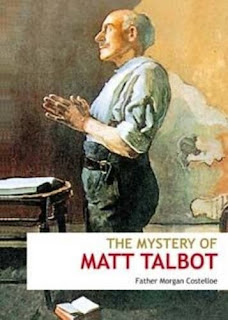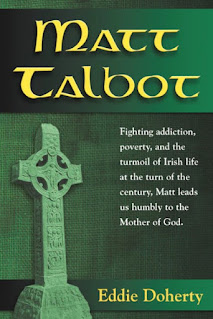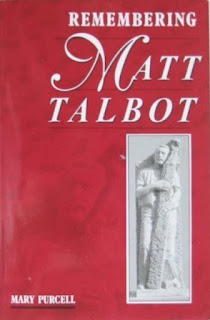This is one of two volumes written about Matt Talbot by Father Costelloe, who at the time of writing this volume was the Vice-Postulator for the cause of Venerable Matt Talbot, the other is titled Matt Talbot: Hope for Addicts which had 2 editions in 1989 one by Veritas and one by Hyperion Books. This is one of several volumes I have read about Matt Talbot this year, this is the eighth such volume, and I have at least that many I would still like to track down. This is one I received a scanned copy of from the National Library of Ireland, for they will scan out of print volumes for a price. A service I am very grateful for. This volume received the Nigil Obstat and Imprimi Potest. The copy I have does not have a back cover, so I have no description from the dust jacket. The inside front cover has 5 quotes of how others saw Matt, they are:
“He was a pleasant man and would laugh and talk with visitors. He sought to conceal his prayers and fasts.”
Mrs Mary Andrews, his sister.
“He was a pleasant, approachable and kindly man. He had a lovely smile. He seemed completely oblivious of what happened around him when he was praying.”
Sean T. O'Cea llaigh, altar server, later President of Ireland.
“At our first meeting I tried to ascertain whether the Servant of Cod was quite a normal man - free from eccentricities and with commonsense views on religious matters. He made a most favourable impression on me. Th ere was nothing nervy or over-wrought in his manner.”
Raphael O'Callaghan, Company Director and a close friend.
“He carefully avoided all ostentation, especially as regards his penances. He was a good, conscientious workman. I never met anybody like him. He was totally wrapped up in Cod.”
Daniel Manning, fellow worker in the timber yard.
"Before I was married, I used visit him frequently, and I always found him very gentle, good-humoured and ready to enjoy a joke."
Mrs Annie Johnson, his niece.
The sections in this booklet are:
Introduction
Irish Monasticism
Means Towards an End
Well-tried Faith
The ‘Hard’ Man
Change of Life Style
Hymns from the Top Flat
The Irish Way
Praising God
One Full Meal
Monks at Work
And So to School
‘Green’ Martyrdom
Pilgrims for Christ
Queen of Ireland
The Mystery of Matt Talbot
‘Old Reliable’
Lost in Prayer
The Word of God
The Good Queen
A Cluster of Books
The Thought of Others
Matt’s Menu
Unskilled Labourer
‘No Time for Money’
Mission to China
The Folly of Christ
‘A Holy, Old Man.’
Totus Tuus
No Half-Measure
The Irish Dimension
While reading this volume I highlighted numerous passages. Some of them are:
“As the Vice-Postulator of the Cause of Venerable Matt Talbot, I have heard similar remarks in Ireland and abroad. There is an aspect of his spirituality that appears forbidding and mysterious. Where did he get the idea for his fasts, his long night vigils and his awesome asceticism? The answer is that, under the guidance of a spiritual director, he imitated the life of the monks in the early Irish monasteries.”
“This booklet is not another biography of Matt Talbot. It presupposes that the reader has heard his life-story which is well told in Mary Purcell's Matt Talbot and his. Times and Father Edward O'Connor's Spotlight on the Venerable Matt Talbot. The purpose of this booklet is to explain the spiritual programme that led him to close union with God.”
“Many Irish persons today have lost a sense of history. They can name some of the great monasteries like Clonard, Glendalough and Clonmacnois, which became world famous through the visit of Pope John Paul 111979, but they know little about the life of the monks who lived there. They go on pilgrimage to Lough Derg. known as St Patrick's Purgatory, without realising that this penitential exercise has its roots in early Irish spirituality which has always emphasised the need for penance: ' Unless you repent you will all likewise perish' (Lk 13:3).”
“One of the extraordinary events in our history was the widespread interest in the monastic life which manifested itself within a hundred years of the death of St Patrick by the end of the sixth century there were thirty major monastic settlements scattered through the country and we are told of young men and women flocking to consecrate their lives to God. At first a hermit would set up his cell m a secluded spot to communicate with God in private; but the news would spread and others would gather around. him to seek his advice on prayer. Eventually small self-suff1c1ent communities were formed and the hermit's life, in the strict sense, was almost a thing of the past. The spiritual acorn became a mighty oak, some monasteries having as many as four thousand people including overseas students. Glendalough and Clonmacnois became university cities of their day, while remaining. like all the monasteries, places of prayer, solitude and study.”
“Life in the monasteries was summed up by St Columbanus as 'pray daily, fast daily, study daily, work daily' (Opera p.24). The great monks, who were proposed as models, were those who persevered in strict obedience to their Abbot, over forty or fifty years.”
“They held that if they could reduce its need for food, sleep and comfort to a minimum they would produce maximum response to God's inspiration for prayer and charity.”
“Asceticism was the order of the day in monastic I re land. It was so strict that scholars look to the Eastern Church to find anything like it Innumerable prostrations and genuflections during prayer were common.”
“This spiritual father was given the beautiful Irish title of 'anamchara', which translated into English, means ' soul-friend'. He was both confessor and advisor, who constantly reminded the monk that austerity was not an end in itself, only a means towards closer union with God. The need for an individual spiritual director was considered so important that novices were told that a monk without one was 'like a body without a head'.”
“There was nothing easy about life in these (Irish monastic) communities. Their ways of ascetic piety would be regarded by most men of the twentieth century as quite insane'. He goes on: 'All the monks submitted to a penitential regime, which seems astounding to our easy-going ways. The ideal of penance was what these men set out to find in cells lost in the midst of woods or in the most desolate countryside. The finest examples of a well-tried faith we reforged here' (Introduction to Ireland: Isle of Saints by G & B Cerebeland-Salagnance).”
“It was an unlikely beginning of a deep intimacy between him and his Saviour that would bridge the next forty years. To strengthen his resolution further, he decided to attend Mass and receive Holy Communion every day before work It was a revolutionary ideal In Ireland of the 1880's a good-living layman went to the altar just twice a year, at Easter and at Christmas. A nun or a Brother with religious vows went only on Sundays.”
“To fill in his time after hours and to satisfy his increasing interest in religious matters, he joined the Third Order of St Francis attached to the Franciscan Church, Merchant's Quay. He continued to go to Mass and Holy Communion every morning in the Jesuit church, Gardiner Street near his home and became a member of its Workingmen's Sociality dedicated 'to Our Lady Immaculate.”
“Although illiterate when he left school, he gradually learned to read and write. Matt became friendly with another priest, Dr. Michael Hickey, later Monsignor, of Holy Cross College, Clonliffe, who played a major role in his spiritual formation. An enlightened confessor and scholar, he became Matt's director, a true 'anamchara' guiding him in the way of Irish spirituality.”
“When we consider the principal elements in the life of the early Irish monk, it is easy to see how they were parallelled in the life of this Dublin workman. These were: prayer, fasts, mortifications, work, study, devotion to Our Lady and missionary drive. Let us consider each in turn.”
“The monk was a 'miles Christi', a soldier of Christ, who set out to conquer self in order to draw closer to God. It was a kind of martyrdom, as the monks acknowledged. Few Irish monks suffered red martyrdom -shedding their blood for the sake of the Gospel- although St Killian and his companions did when they travelled to Wurtzburg in Germany. But all the Irish monks were expected to achieve what was called 'white' martyrdom•- ·the renunciation of everything one loved, living in complete poverty of spirit. There was a higher stage on the way to perfection, however, for monks who performed additional penance by fasting and labour and sought the profoundest humility. The monks described this as 'green' martyrdom.”
“He continued to attend Mass and to receive Holy Communion at5 o'clock Mass every morning in Gardiner Street Church. But when the time of this first Mass was changed to 6.15 Matt discovered that he was unable to return home for his breakfast and get to work in time, so he changed his job.”
“Even during the Easter Rising of 1916 he made his way through military barricades to attend Mass. Sunday was D-day. He went to first Mass and
stayed in the church until the last Mass concluded with Benediction. Since he was obliged to fast from midnight in order to receive Holy communion, he did not have his breakfast until after 1.30 p.m. Occasionally he moved from one church to another on Sundays, depending on where his various Sodalities met He might slip away from the Jesuit Church, Gardiner Street to the Franciscan Church, Merchant's Quay or to the Dominican Church, Dominick Street.”
“He made himself as inconspicuous as possible, a small, poor man. He never used a prayer book but prayed with his eyes shut He knelt erect in the bench, hour after hour, with his hands joined in front of him. He did not allow them to rest on the seat in front of him and so remained upright without support He did not stand for the gospel, a habit he learned from a saint to retain recollection. To the members of the Franciscan Church choir, who saw him from the gallery huddled in deep prayer, he was affectionately known as the ' old reliable'.”
“His visits to a church were not limited to Mass time. He paid a visit to the Blessed Sacrament on his way to work, 'to see the Lord on the way down', as he said, and again after work 'to see the Lord on the way home'. Remembering that as a rule he returned to a church after his evening meal for a Sodality meeting. he saw a lot of the Lord.”
“His little room at 18 Upper Rutland Street had the bare necessities of a monastic cell. He had an iron bedstead, a chair, a table, a crucifix and a few holy pictures. His bed covering was a sheet and a half blanket, supplemented by an old sack during the cold winter nights.”
“He recited fifteen decades of the Rosary and the Little Office of the Blessed Virgin every day. He made Novenas for her feast days. He turned to her for guidance when a girl proposed marriage. There were five books about Our Lady found in his library and as we will see, it was through his devotion to her that his secret life of prayer, charity and penance was revealed to the world.”
“His spiritual books provided food for prayer, meditation and a deeper understanding of the Faith, but they provided a formidable challenge for a man, who could neither read nor write when he left school. He had painstakingly overcome these handicaps as an adult, but he explained that he read books very slowly, and prayed to the Holy Spirit {or enlightenment.”
“But there were not many ordinary days. Even in the early years of his conversion, be observed a ' black fast' during Lent and again during June in honour of the Sacred Heart. He had a ' black fast' during · Advent to prepare for Christmas and another after Easter in preparation for Pentecost Every Saturday he fasted on dry bread and black tea in honour of Our Lady.”
“He was agreeable and cheerful with the other workmen. He was more silent and recollected than they were but they liked him and respected him.”
“He lived his life of asceticism for almost forty years, largely unnoticed by his workmates and neighbours. On reflection, he struck them as the perfect example of self-abasement - poor, clean and shabbily dressed, but always alert to the needs of others. Towards the end of his life he seemed to live in the presence of God.”
“He concealed his life of asceticism and settled into the _routine of patients, receiving Holy Communion just once a week and eating the ordinary hospital meals. Sister Mary Dolores, who looked after him during that time, was amazed when she discovered, years later, that she had nursed the Servant of God.' Matt Talbot never showed by his conduct' she said later at the sworn inquiry of the Ordinary Process, 'that he was anything more than a sweet-natured, holy, old
man'.”
“In the sections 236 to 242 of the book St Louis Marie points out the difference between a child of Mary and a slave of Mary: a child has rights, a slave has surrendered all. It is summarised in the motto of Pope John Paul 11: Totus Tuus ‘Totally yours’. A Christian who considers himself a 'slave of Mary' will live very close to his mistress and therefore, very close to her Son.”
This was an absolutely fascinating read. It was as much a history of Irish monasticism, Irish spirituality, and history as the story of Matt. And being written by the then postulator it was intriguing to see what he focused on compared to other biographies of this saintly man that I have read.
This book is an excellent resource and I believe a few different editions were published; I have seen at least three covers for this volume. It is an amazing read, and I can easily recommend it. Matt is a man whose witness we need today even more than in his time. My own brother overdosed at the beginning of the pandemic. I wish I had discovered Matt and his story years ago to share with my brother. The number of people addicted to alcohol, weed, opioids and other drugs are constantly on the rise. I wish this volume was back in print and available as an eBook, there are dozens of people I would recommend it to. It is well worth tracking down and giving a read.
Note: This book is part of a series of reviews: 2023 Catholic Reading Plan!
For all reviews of books about Matt Talbot Click here.
Books about Matt Talbot:
Matt Talbot and His Times - Mary Purcell
Matt Talbot: His Struggle, His Victory over Alcoholism - Susan Helen Wallace
Matt Talbot - Xavier Carty
Spotlight on Matt Talbot - Edward O'Connor, S.J.
Matt Talbot - Simon O'Brynne
The quest for Matt Talbot - Philip Rooney
We knew Matt Talbot - Albert H Dolan
Matt Talbot - James F. Cassidy.
An address to Pope John Paul II from the Parish of Matt Talbot, The Worker.
Matt Talbot : the Irish worker's glory - James Francis Cassidy
Matt Talbot - Albon White
The Story of Matt Talbot - Malachy Gerard Carroll













No comments:
Post a Comment